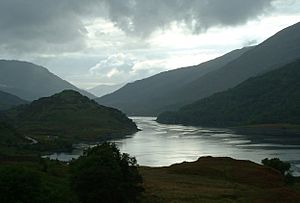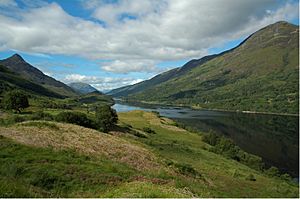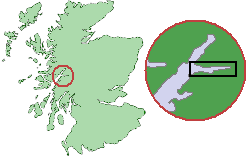Loch Leven (Highlands) facts for kids
Loch Leven (in Scottish Gaelic: Loch Liobhann) is a sea loch on the west coast of Scotland. A sea loch is like a long, narrow arm of the sea that reaches inland.
Contents
Exploring Loch Leven
Loch Leven is about 14 kilometers (8.75 miles) long. It changes in width, from about 200 meters (220 yards) to over 1.6 kilometers (1 mile). The loch connects to Loch Linnhe at its western end. This connection is near North Ballachulish.
Islands of the Loch
Near the western end of Loch Leven, you can find nine small islands. Some of these islands are rocky and covered with heather. Others are smooth and grassy.
Villages Around the Loch
The village of Glencoe is located on the southern shore of Loch Leven. It is famous for its beautiful scenery.
Kinlochleven: A Village Built for Power
At the very end of the loch is the village of Kinlochleven. This village was created when a large aluminium smelter was built there. This happened in the early 1900s. The smelter used the power of water to make aluminium.
Before 1922, it was hard to reach Kinlochleven from the south. People had to travel by boat or walk. A road connecting the village to Glencoe was built in 1922. Another road on the north side of the loch goes to Fort William. This road was finished in 1927.
Crossing the Loch
For many years, a ferry called the Ballachulish Ferry carried people and cars. It crossed the mouth of Loch Leven. This ferry was a very important link on the A82 road. This road connects Glasgow and Fort William.
The Ballachulish Bridge
In 1975, the Ballachulish Bridge was built. This new bridge replaced the ferry. It made travel much easier and faster. Under the bridge, the loch becomes very narrow. This narrow part is called Caolas Mhic Phàdraig.
Tidal Streams and Shipping
The water flows very fast through these narrows. It can reach speeds of up to seven knots (about 13 kilometers per hour) during strong tides. It is important for boats to plan their journey carefully. Further up the loch, there are other narrow spots. These also have strong, but smaller, tidal currents.
One of these narrow spots, Caolas na Con, made it hard for large ships to reach Kinlochleven. However, in 1907, the channel was made deeper. This allowed ships carrying alumina to reach the smelter.




